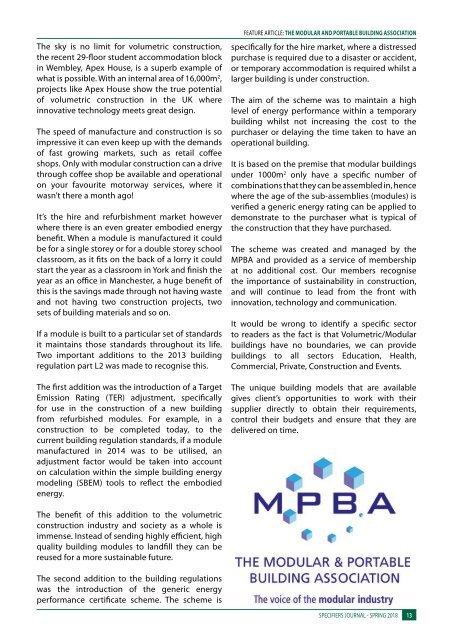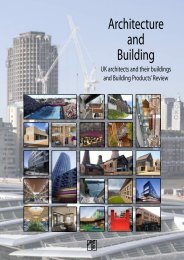ECOBuilder-Specifiers Journal spring2018
Create successful ePaper yourself
Turn your PDF publications into a flip-book with our unique Google optimized e-Paper software.
The sky is no limit for volumetric construction,<br />
the recent 29-floor student accommodation block<br />
in Wembley, Apex House, is a superb example of<br />
what is possible. With an internal area of 16,000m 2 ,<br />
projects like Apex House show the true potential<br />
of volumetric construction in the UK where<br />
innovative technology meets great design.<br />
The speed of manufacture and construction is so<br />
impressive it can even keep up with the demands<br />
of fast growing markets, such as retail coffee<br />
shops. Only with modular construction can a drive<br />
through coffee shop be available and operational<br />
on your favourite motorway services, where it<br />
wasn’t there a month ago!<br />
It’s the hire and refurbishment market however<br />
where there is an even greater embodied energy<br />
benefit. When a module is manufactured it could<br />
be for a single storey or for a double storey school<br />
classroom, as it fits on the back of a lorry it could<br />
start the year as a classroom in York and finish the<br />
year as an office in Manchester, a huge benefit of<br />
this is the savings made through not having waste<br />
and not having two construction projects, two<br />
sets of building materials and so on.<br />
If a module is built to a particular set of standards<br />
it maintains those standards throughout its life.<br />
Two important additions to the 2013 building<br />
regulation part L2 was made to recognise this.<br />
The first addition was the introduction of a Target<br />
Emission Rating (TER) adjustment, specifically<br />
for use in the construction of a new building<br />
from refurbished modules. For example, in a<br />
construction to be completed today, to the<br />
current building regulation standards, if a module<br />
manufactured in 2014 was to be utilised, an<br />
adjustment factor would be taken into account<br />
on calculation within the simple building energy<br />
modeling (SBEM) tools to reflect the embodied<br />
energy.<br />
FEATURE ARTICLE: THE MODULAR AND PORTABLE BUILDING ASSOCIATION<br />
specifically for the hire market, where a distressed<br />
purchase is required due to a disaster or accident,<br />
or temporary accommodation is required whilst a<br />
larger building is under construction.<br />
The aim of the scheme was to maintain a high<br />
level of energy performance within a temporary<br />
building whilst not increasing the cost to the<br />
purchaser or delaying the time taken to have an<br />
operational building.<br />
It is based on the premise that modular buildings<br />
under 1000m 2 only have a specific number of<br />
combinations that they can be assembled in, hence<br />
where the age of the sub-assemblies (modules) is<br />
verified a generic energy rating can be applied to<br />
demonstrate to the purchaser what is typical of<br />
the construction that they have purchased.<br />
The scheme was created and managed by the<br />
MPBA and provided as a service of membership<br />
at no additional cost. Our members recognise<br />
the importance of sustainability in construction,<br />
and will continue to lead from the front with<br />
innovation, technology and communication.<br />
It would be wrong to identify a specific sector<br />
to readers as the fact is that Volumetric/Modular<br />
buildings have no boundaries, we can provide<br />
buildings to all sectors Education, Health,<br />
Commercial, Private, Construction and Events.<br />
The unique building models that are available<br />
gives client’s opportunities to work with their<br />
supplier directly to obtain their requirements,<br />
control their budgets and ensure that they are<br />
delivered on time.<br />
The benefit of this addition to the volumetric<br />
construction industry and society as a whole is<br />
immense. Instead of sending highly efficient, high<br />
quality building modules to landfill they can be<br />
reused for a more sustainable future.<br />
The second addition to the building regulations<br />
was the introduction of the generic energy<br />
performance certificate scheme. The scheme is<br />
SPECIFIERS JOURNAL - SPRING 2018<br />
13







